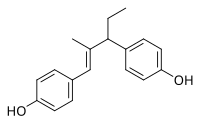 | |
| Identifiers | |
|---|---|
| |
| Chemical and physical data | |
| Formula | C18H20O2 |
| Molar mass | 268.356 g·mol−1 |
| 3D model (JSmol) | |
| |
| |
Dianol is a synthetic, nonsteroidal estrogen that was never marketed.[1] It is a dimer and impurity of anol, and was, along with hexestrol, involved in erroneous findings of highly potent estrogenic activity with anol.[2][3][4] Although a potent estrogen, it requires a dose of 100 μg to show activity, whereas hexestrol shows activity with a mere dose of 0.2 μg.[5]
See also[edit]
References[edit]
- ^ Dodds EC (2008). "Synthetic œstrogens in treatment". The Irish Journal of Medical Science. 25 (7): 305–314. doi:10.1007/BF02950685. ISSN 0021-1265. S2CID 58062466.
- ^ Maximov PY, McDaniel RE, Jordan VC (23 July 2013). "Discovery and Pharmacology of Nonsteroidal Estrogens and Antiestrogens". Tamoxifen: Pioneering Medicine in Breast Cancer. Milestones in Drug Therapy. Springer Science & Business Media. pp. 3–. doi:10.1007/978-3-0348-0664-0_1. ISBN 978-3-0348-0664-0.
- ^ Dodds EC (1 January 1945). "Possibilities in the Realm of Synthetic Estrogens". In Harris RS, Thimann KV (eds.). Vitamins and Hormones. Vol. 3. Academic Press. pp. 232–. doi:10.1016/S0083-6729(08)61113-9. ISBN 978-0-08-086600-0.
- ^ Ravina E (11 January 2011). "Nature as a Source of Drugs: Drugs from Natural Products". The Evolution of Drug Discovery: From Traditional Medicines to Modern Drugs. John Wiley & Sons. pp. 177–. ISBN 978-3-527-32669-3.
- ^ Solmssen UV (December 1945). "Synthetic estrogens and the relation between their structure and their activity". Chemical Reviews. 37 (3): 481–598. doi:10.1021/cr60118a004. PMID 21013428.